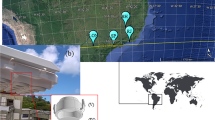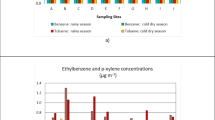Abstract
Mixing ratios of 15 carbonyls and BTEX (benzene, toluene, ethyl benzene, xylenes) were measured for the first time in ambient air of Kolkata, India at three sites from March to June 2006 and their photochemical reactivity was evaluated. Day and nighttime samples were collected on weekly basis. Formaldehyde was the most abundant carbonyl (mean concentration ranging between 14.07 μg m−3 to 26.12 μg m−3 over the three sites) followed by acetaldehyde (7.60–18.67 μg m−3) and acetone (4.43–10.34 μg m−3). Among the high molecular weight aldehydes, nonanal showed the highest concentration. Among the mono-aromatic VOCs, mean concentration of toluene (27.65–103.31 μg m−3) was maximum, closely followed by benzene (24.97–79.18 μg m−3). Mean formaldehyde to acetaldehyde (1.4) and acetaldehyde to propanal ratios (5.0) were typical of urban air. Based on their photochemical reactivity towards OH· radical, the concentrations of the VOCs were scaled to formaldehyde equivalent, which showed that the high molecular weight carbonyls and xylenes contribute significantly to the total OH-reactive mass of the VOCs. Due to the toxic effect of the VOCs studied, an assessment for both cancer risk and non-cancer hazard due to exposure to the population were calculated. Integrated life time cancer risk (ILTCR) due to four carcinogens (benzene, ethyl benzene, formaldehyde and acetaldehyde) and non-cancer hazard index for the VOCs at their prevailing level were estimated to be 1.42E−04 and 5.6 respectively.
Similar content being viewed by others
Reference
Altshuller, A. P., Cohen, I. R., Sleva, S. F., & Kopczynski, S. L. (1962). Air pollution: Photooxidation of aromatic hydrocarbons. Science, 138, 442–443.
Anderson, L. G., Lanning, J. A., Barrell, R., Miyagishima, J., Jones, R. H., & Wolfe, P. (1996). Sources and sinks of formaldehyde and acetaldehyde: an analysis of Denver’s ambient concentration data. Atmospheric Environment, 30, 2113–2123.
Atkinson, R. (2000). Atmospheric chemistry of VOCs and NOx. Atmospheric Environment, 34, 2063–2101.
Báez, A. P., Belmont, R., & Padilla, H. (1995). Measurements of formaldehyde and acetaldehyde in the atmosphere of Mexico City. Environmental Pollution, 89, 163–167.
Bakeas, E. B., Argyris, D. I., & Siskos, P. A. (2003). Carbonyl compounds in the urban environment of Athens, Greece. Chemosphere, 52, 805–813.
Bravo, H., Sosa, R., Sanchez, P., Bueno, E., & Gonzalez, L. (2002). Concentrations of benzene and toluene in the atmosphere of the southwestern area at the Mexico City Metropolitan Zone. Atmospheric Environment, 36, 3843–3849.
Cerón, R. M., Cerón, J. G., & Muriel, M. (2007). Diurnal and seasonal trends in carbonyl levels in a semi-urban coastal site in the Gulf of Campeche, Mexico. Atmospheric Environment, 41, 63–71.
Correa, S., Martins, E., & Arbilla, G. (2003). Fomaldehyde and acetaldehyde in a high traffic street of Rio de Janeiro, Brazil. Atmospheric Environment, 37, 23–29.
Crump, K. S. (1994). Risk of benzene-induced leukaemia: A sensitivity analysis of the pliofilm cohort with additional follow-up and new exposure estimates. Journal of toxicology and environmental health, 42, 219–242.
Darnall, K. R., Lloyd, A. C., Winer, A. M., & Pitts Jr., J. N. (1971). Reactivity scale for atmospheric hydrocarbons based on reaction with hydroxyl radical. Environmental Science & Technology, 5, 1009–1016.
DeMore, W. B., Sander, S. P., Golden, D. M., Hampson, R. F., Kurylo, M. J., Howard, C. J., et al. (1992). Chemical kinetics and photochemical data for the use of stratospheric modelling: Evaluation number 10. Pasadena, CA: JPL Publication 92-20, Jet Propulsion Labs.
Feng, Y., Wen, S., Chen, Y., Wang, X., Lu¨, H., Bi, X., et al. (2005). Ambient levels of carbonyl compounds and their sources in Guangzhou, China. Atmospheric Environment, 39, 1789–1800.
Finlayson-Pitts, B. J., & Pitts, J. N. J. (2000). Chemistry of the upper and lower atmosphere. San Diego: Academic.
Grosjean, D. (1982). Formaldehyde and other carbonyls in Los Angeles ambient air. Environmental Science & Technology, 16, 254–62.
Grosjean, E., & Grosjean, D. (1998). Formation of ozone in urban air by photochemical oxidation of hydrocarbons: Captive air experiments in Porto Alegre, RS. Journalof the Brazilian Chemical Society, 9, 131–143.
Hell’en, H., Hakola, H., Reissell, A., & Ruuskanen, T. M. (2004). Carbonyl compounds in boreal coniferous forest air in Hyytiälä, Southern Finland. Atmospheric Chemistry and Physics, 4, 1771–1780.
Ho, K. F., Lee, S. C., Louie, K. K., & Zou, S. C. (2002). Seasonal variation of carbonyl compound concentrations in urban area of Hong Kong: Asia. Atmospheric Environment, 36, 1259–1265.
Ilgen, E., Karfich, N., Levsen, K., & Angerer, J. (2001). Aromatic hydrocarbons in the atmospheric environment: Part I. Indoor Versus outdoor sources, the influence of traffic. Atmospheric Environment, 35, 1235–1252.
Jacobs, M. B., & Hochheiser, S. (1958). Continuous sampling and ultra-micro determination of nitrogen dioxide in air. Analytical Chemistry, 30, 426.
Kawamura, K., Steinberg, S., & Kaplan, I. R. (2000). Homologous series of C1–C10 monocarboxylic acids and C1–C6 carbonyls in Los Angeles air and motor vehicle exhausts. Atmospheric Environment, 34, 4175.
Khare, P., Satsangi, G. S., Kumar, N., Kumari, K. M., & Srivastava, S. S. (1997). HCHO, HCOOH and CH3COOH in air and rain water at a rural tropical site in north central India. Atmospheric Environment, 31, 3867–3875.
Lai, C. H., & Chen, K. S. (2004). Characteristics of C2–C15 hydrocarbons in the air of urban Kaohsiung, Taiwan. Atmospheric Environment, 38, 1997–2011.
MPTT. (2001). Master plan for traffic and transportation in Calcutta Metropolitan area 2001–2025. Kolkata Metropolitan Development Authority.
MohanRao, A. M., Pandit, G. C., Sain, P., Sharma, S., Krishnamoorthy, T. M., & Nambi, K. S. V. (1996). Non-methane hydrocarbons in industrial locations of Bombay. Atmospheric Environment, 31, 1077–1085.
Montero, L., Vasconcellos, P. C., Souza, S. R., Pires, M. A. F., Sanchez-ccoyllono, O. R., Andrade, M. F., et al. (2001). Measurements of atmospheric carboxylic acids and carbonyl compounds in Saõ Paulo City, Brazil. Environmental Science & Technology, 35, 3071–3081.
Moussa, S. G., El-Fadel, M., & Saliba, N. A. (2006). Seasonal, diurnal and nocturnal behavoiurs of lower carbonyl compounds in the urban environment of Beirut, Lebanon. Atmospheric Environment, 40, 2459–2468.
Nguyen, H. T., Takenaka, N., Bandow, H., Maeda, Y., Oliva, S., Botelho, M., et al. (2001). Atmospheric alcohols and aldehydes concentrations measured in Osaka, Japan and in Sao Paulo, Brazil. Atmospheric Environment, 35, 3075–3083.
Pang, X., & Mu, Y. (2006). Seasonal and diurnal variations of carbonyl compounds in Beijing ambient air. Atmospheric Environment, 40, 6313–6320.
Possanzini, M., Di Palo, V., & Cecinato, A. (2002). Sources and photodecomposition of formaldehyde and acetaldehyde in Rome ambient air. Atmospheric Environment, 36, 3195–3201.
Possanzini, M., Di Palo, V., Preticca, M., Fratarcangeli, R., & Brocco, D. (1996). Measurements of lower carbonyls in Rome ambient air. Atmospheric Environment, 30, 3757–3764.
Sin, D., Wong, Y. C., & Louie, P. K. (2001). Trends of ambient carbonyl compounds in the urban environment of Hong Kong. Atmospheric Environment, 35, 5961–5969.
Som, D., Dutta, C., Chatterjee, A., Mallick, D., Jana, T. K., & Sen, S. (2007). Studies on commuters’ exposure to BTEX in passenger cars in Kolkata, India. Science of the Total Environment, 372, 426–432.
Srivastava, A., Joseph, A. E., Patil, S., More, A., Dixit, R. C., & Prakash, M. (2005). Air toxics in ambient air of Delhi. Atmospheric Environment, 39, 59–71.
Uchiyama, S., Matsushima, E., Aoyagi, S., & Ando, M. (2004). Simultaneous determination of C1–C4 carboxylic acids and aldehydes using 2, 4-dinitrophenylhydrazine-impregnated silica gel and high-performance liquid chromatography. Analytical Chemistry, 76, 5849–5854.
Uebori, M., & Imamura, K. (2004). Analysis of aliphatic and aromatic carbonyl compounds in ambient air by LC/MS/MS. Analytical Science, 20, 1459.
USEPA. (1993). Code of Federal Regulations. Title, Part 58.Ambient air quality surveillance. Final Rule Federal Register, vol. 58(28), 12 February
USEPA. (1997). Air risk assessment workplan. United States Environmental Protection Agency Regions 3, 4, and 5 Ohio Environmental Protection Agency Division of Air Pollution Control Kentucky Department of Environmental Protection.
Viskari, E., Vartiainen, M., & Pasanen, P. (2000). Seasonal and diurnal variation in formaldehyde and acetaldehyde concentrations along a highway in Eastern Finland. Atmospheric Environment, 34, 917–923.
Wang, X., Sheng, G., Fu, J., Chan, C., Lee, S. C., Chan, L. Y., et al. (2002). Urban roadside aromatic hydrocarbons in three cities of the Pearl River Delta, People’s Republic of China. Atmospheric Environment, 36, 5141–5148.
Author information
Authors and Affiliations
Corresponding author
Rights and permissions
About this article
Cite this article
Dutta, C., Som, D., Chatterjee, A. et al. Mixing ratios of carbonyls and BTEX in ambient air of Kolkata, India and their associated health risk. Environ Monit Assess 148, 97–107 (2009). https://doi.org/10.1007/s10661-007-0142-0
Received:
Accepted:
Published:
Issue Date:
DOI: https://doi.org/10.1007/s10661-007-0142-0




